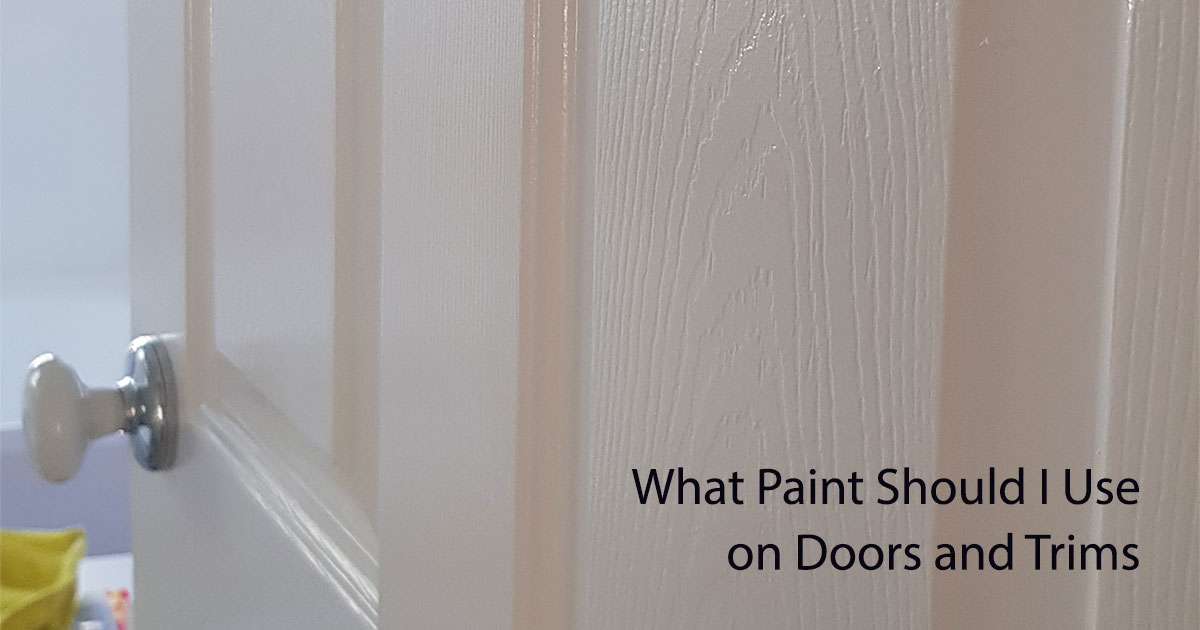What Paint Should I Use on Doors and Trims – Tips From a Professional Painter in Perth, WA

One of the most common questions we get from our clients is "what is the best paint to use when it comes to painting internal doors and frames?"
Today we are looking at the difference between acrylic (water based) paint vs enamel (oil based) paint and which one would be the best to use when it comes to internal doors, frames, and skirtings.
Traditionally, all trims were painted with turpentine-based enamel gloss or semi-gloss paint. However, with the paint technologies improving over time and environmental regulations becoming stricter, an acrylic water-based gloss or semi-gloss finish has become an alternative option.
That said, here are the advantages and disadvantages of using both of these paints.
Oil Based Enamel Gloss or Semi-Gloss
This paint has been a preferred choice for painters for many years as it provides a smooth finish and excellent durability. The drying time of oil paint is slower than acrylic which allows painters extra time to achieve a great finish. It levels better so you see fewer brush or roller marks. However, it has some disadvantages over water based acrylic.
- Odour/High VOC - firstly, the strong smell of oil paint can cause inconvenience and it is certainly not healthy for humans and the environment. Some of our clients would even try to book their painting project for when they are away, preferring to come back home once the smell has settled.
- Yellowing - one of the main differences with oil paint is the fact that it tends to yellow over time which is especially noticeable with white or light colours. Discoloration will occur more in areas of the house where there is not enough UV light.
- Easier to chip - oil-based paint is harder than acrylic which makes it more difficult to scratch or leave marks, however it is also easier to chip. And once chipped it is more difficult to touch up, as you need to undercoat bare metal first prior to painting.
- Harder to repaint - when repainting surfaces previously painted with oil paint you generally want to use oil-based undercoat to make sure that new paint adheres to the surface properly. With water-based paint you can paint straight over oil painted surfaces, providing that the surface is in good condition and prepared correctly or you can also use a water-based undercoat.
- Disposal and Clean up - in the use of enamel paints, the process of disposal is far more complicated. It can’t be thinned down with water like acrylic paint. It needs to be left to dry or taken to a paint recycling company thereby incurring extra costs.
Acrylic Gloss or Semi-Gloss Paint
This type of paint is now widely used for painting internal doors, frames, and skirting boards. In fact, the use of water based acrylic paint has now become mandatory for a lot of construction projects nowadays. It is environmentally friendly, has low odour and VOC (Volatile Organic Compounds) and, one of the main advantages is that it doesn’t yellow over time. Acrylic paint is also more flexible than enamel paint which makes it less likely to chip. It is washable and can be cleaned just as easily as enamel. Also, overall, acrylic paints are easier to maintain and repaint over time.
Here are a number of things to keep in mind when choosing to use Acrylic Gloss:
- Shows more brush marks - one of the main reasons a lot of painters prefer not to use acrylic gloss or semi-gloss paint is that the finish is not as smooth as with oil paint. Acrylic paint will show slightly more brush marks and will have heavier roller texture compared to enamel paints unless it is applied by spray-painting which guarantees a smooth finish.
- Harder to work with - water based paint dries a lot quicker than enamel paint which makes it harder for the painter to work with. Gloss and Semi-gloss acrylic paint shows a lot of imperfections and has to be applied with a lot of care to ensure the smoothest possible finish.
- Lower Opacity - acrylic paint doesn’t cover as well as oil-based enamel especially with the semi-gloss finish. It often requires extra coats to make sure that previous colour is completely covered and not showing through. The job can take longer and cost more.
- Easier to mark - acrylic paint will get marked easier and, even though it is still washable, over time you would need to repaint it sooner than oil enamel.
- More Expensive - with acrylic paint you generally have to apply at least two topcoats because the coverage is not as good as with enamel paint and also to achieve smoother finish. That makes it more time and material consuming and, as a consequence, more expensive for the client.
Overall, we can say that the industry is slowly moving towards the sole use of acrylic paints. Even though an enamel finish certainly looks better, the harsh chemicals in it affects the environment and are poisonous to humans. A strong turpentine smell lingers in the area where its used for a significant amount of time and causes discomfort for the residents.
However, the difference in quality and the drying time between two products makes a lot of painters continue using enamel paint.
Our Recommendation
When I am asked this question, I always recommend to firstly assess the condition of existing surfaces. If the surfaces you are planning to paint have a lot of imperfections present it is better to use enamel paint. I also determine how much light is in the house. If there is not a lot of natural light and white, light colour is being proposed, it’s certainly better to use acrylic paint. If the walls in the house are white (or getting painted white) it’s always better to have the trims painted in acrylic paint, otherwise the discoloration compared to adjacent white walls will be very obvious.
Smell cannot always be avoided even with an acrylic finish. Unless existing doors and frames are new or painted with acrylic already, an oil-based undercoat still needs to be used prior to painting over with acrylic.
Finally, always try to get advice from a professional licensed painter. Every situation is different, and a lot of factors need to be taken into consideration for the best and most economical outcome.
For any further questions or if you are looking for some advice for your next painting job, contact us at Cosmic Painting.

